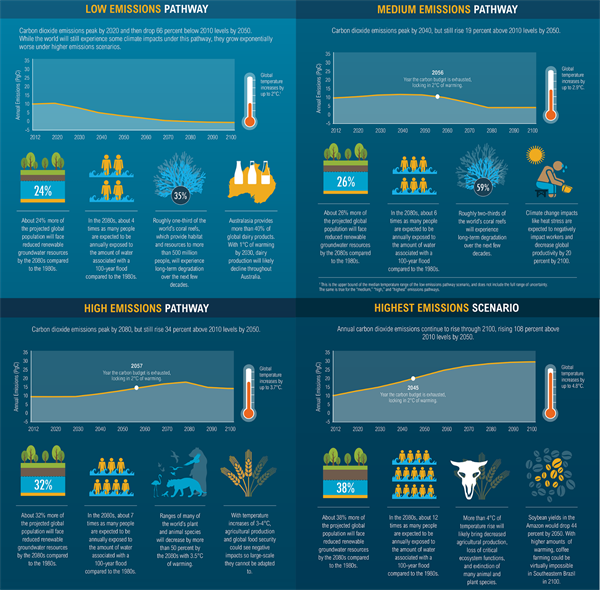Mat Hope
08.08.2014 | 11:45amWhat happens if humans keep emitting greenhouse gases? Answering that question is at the core of a lot of climate change research. But communicating the often complex findings isn’t easy.
WRI’s infographic is based on four scenarios used in the IPCC’s reports, known as representative concentration pathways (RCPs).Late last year, the Intergovernmental Panel on Climate Change (IPCC) released three reports synthesising what the latest research had to say on the matter. Those documents were quite dense, so thinktank the World Resources Institute (WRI) has tried to condense the information into four, colourful panels:
Source: World Resources Institute
The IPCC looks at a wide range of potential futures depending on the level of global greenhouse gas emissions up to 2100. To model the impacts associated with different emissions levels, it developed a range of pathways – the RCPs. We’ve discussed them in detail before, but here’s the headlines.
In the IPCC’s best case scenario – the “lowest emissions pathway” on the infographic – emissions peak by 2020, then drop 66 per cent below 2010 levels by 2050. That should curb global warming to two degrees above pre-industrial levels, the IPCC says – the internationally agreed target.
Getting emissions to peak in 2020 is a pretty mammoth task, given global emissions are continuing to rise. Many analysts – including big corporations such as BP and Shell – think keeping warming to two degrees is now unlikely.
There are still impacts associated with two degrees of warming, from increased flooding risks, to coral degradation.
In the IPCC’s worst case scenario – the “highest emissions pathway” on the graphic – emissions continue to rise beyond 2100. Under that scenario, emissions are 108 per cent higher than 2010 levels by 2050.
Such emissions could lead to up to 4.8 degrees of warming leading to mass species extinction, significantly reduced crop yields, and groundwater shortages, the IPCC says.
Uncertainties and risks
The IPCC’s scenarios aren’t meant to be predictions of the future. Instead, they’re intended to give insights into the risks societies and ecosystems experience depending on the extent of greenhouse gas emissions.
Uncertainties remain. Scientists don’t currently know when particular ecosystem tipping points may be passed, for example.
But The IPCC’s overall message is that the risks of “severe, pervasive, and irreversible impacts” increase as emissions and temperatures rise.
-
Infographic: Cutting emissions to avoid the worst impacts of climate change


